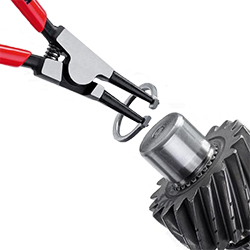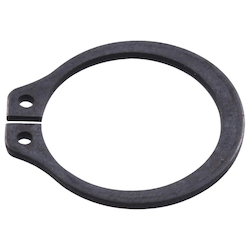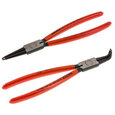Snap Ring Pliers Buying Guide and Tips For Usage

Figure 1: A pair of Knipex snap ring pliers
Snap ring pliers enable the handling of snap rings that secure components in machinery and equipment. Selecting the right pair of snap ring pliers is crucial for both ease of use and the longevity of the tool. This buying guide provides a comprehensive overview of the the various kinds available, how to select between them, and how to use them for your applications.
Note: A snap ring is sometimes referred to as a retaining ring, circlip, or C-clip. The specially designed pliers are for installing or removing them.
View Tameson's selection of snap ring pliers!
Table of contents
- How do snap rings work?
- How do snap ring pliers work?
- Types of snap ring pliers
- Snap ring plier sizes
- How to use snap ring pliers
How do snap rings work?

Figure 2: A snap ring
Snap rings are fasteners used for axial fixation of components on shafts or bores. They are installed in grooves and provide a shoulder to prevent any lateral movement of components, like bearings. However, they still allow for rotation of the component. The unique design of snap rings locks them into place, we use snap ring pliers for installation and removal.
An open-ended design on snap rings adds spring tension. Once fitted, the spring pressure effect prevents the snap ring from slipping or moving, therefore, retaining rings are ideal for use in machine grooves to hold components in place on a shaft. They offer an efficient and secure way to fasten mechanical parts together.
A small hole on snap rings, located on each side of the open end, enables installation with snap ring pliers. Those who regularly work with snap ring fasteners should always have a pair on hand. Modern assemblies, production, machining, and engineering applications rely heavily on snap rings since they are easy to install and use. Many workplaces, including automotive bodies and engines, heavy machinery, transformers, turbines, and pistons use them.
How do snap ring pliers work?
A snap ring pliers is a hand tool used for installing and removing snap rings. These are different from other pliers as they have a specially designed tip for handling snap rings. The tip of standard plier models generally features a flattened or sharpened shape. The tips have a shape that fits precisely into the grip holes. This allows for easy manipulation and repositioning of the snap ring.
Typically, these pliers are designed to work with snap rings of a specific diameter. Snap rings vary in size and so do the pliers. Therefore, its essential to choose the right pair for the type and size of snap rings youll be using.
Types of snap ring pliers
There are several different types of snap ring pliers available. There are two main types: internal and external snap ring pliers. Snap rings with internal rings and rings with external rings have some defining differences. It requires a different tool to manipulate each successfully. It requires a different tool to manipulate each successful which comes with the distinction internal or external.
Furthermore, specific snap ring pliers can switch between snap rings that can function in both directions. These models have the name convertible or reversible snap ring pliers. Snap ring pliers come either with straight or bent tips. The best choice depends on the kinds of installations and access conditions you will encounter most often.
Outer snap ring pliers
The position of an external snap ring is in a slot around the outside of a shaft or dowel, exerting their spring force inwards towards the shaft as a means of providing grip. Therefore, the external snap rings must opens up when being installed using external snap ring pliers. Squeezing the handles causes the tips of the pliers to open up, expanding the snap ring expand to slot over a shaft.
Inner snap ring pliers
An internal snap ring design allows installation inside a hollow, cylindrical housing. The spring action pushes outward against the sides. An internal snap ring plier works the opposite way to an external snap ring plier. The tips of internal snap ring pliers close together when the user squeezes the handle. When the snap ring is in place, the releasing the handle ensures the ring returns to its maximum diameter.
Long nose snap ring pliers
Longnose snap ring pliers accommodate longer shafts or bores. You can use them to insert and remove snap rings in more difficult-to-reach places. These pliers feature longer tips to make working with them more manageable. Longnose internal pliers are more common than external versions. This is due to internal snap rings being more challenging to insert inside of deeper bores than around them.
Heavy-duty snap ring pliers
The design of heavy-duty snap ring pliers enables installing, removing, or manipulating much bigger retaining rings. Industrial pliers are typically used for assembly and repairs of larger machinery. The blades are generally made from toughened materials, such as heat-treated steel, and may have galvanized tips for increased hardness. Furthermore, heavy-duty pliers are more likely to include additional safety mechanisms and benefits. For example, ratchet locking mechanisms enables better control and a more secure grip against higher-gauge snap rings.
Snap ring plier sizes
Note that a snap rings diameter refers to the width of the shaft, dowel, or bore designed to encircle or slot into. Internal retaining rings are measured by their outer diameter, while external rings are measured by their inner diameter. The wide range of snap ring sizes used in everyday applications means youll generally find a similar range of pliers on the market. Its important to know which gauges of snap rings you will be working with before you buy since each pair is designed for use with specific size snap rings. Alternatively, a full range may be a better option for greater flexibility in the future.
Large snap ring pliers
Generally speaking, the term large snap ring pliers refers to tools designed for snap rings up to a diameter of about 500mm, or 20". However, you can also find more specialized models that can handle much larger retaining rings. A few tools will accommodate snap rings up to 1000mm diameter (40") or more. These large snap ring pliers typically have straight tips but can also have bent tips to be used for specific jobs and access points.
Small snap ring pliers
Sometimes tiny snap ring pliers are needed, sometimes referred to as miniature snap ring pliers. These are typically used for snap ring diameters as small as 0.5mm, or 0.02". Some manufacturers offer even more finely detailed tools if needed. These tend to be less available, but they can also be found with straight or bent tips.
How to use snap ring pliers
To choose the best pliers for a job, you must first determine the size of the retaining ring you’re working with. Next, you must determine if you have an internal or external snap ring.
Internal snap ring installation and removal
- Insert the snap ring pliers into the snap rings lug holes.
- The retaining ring diameter will shrink by bringing the pliers tips together as you squeeze the handles.
- Make sure you are only applying enough force to the snap ring to insert/remove it into the desired position (additional force can damage or break it).
- If installing one, put the snap ring inside the groove where it will sit in the shaft or bore, holding the pliers steady.
- Only release the pliers when the snap ring has been firmly seated or removed.
Installing and removing external snap rings
- Put the snap ring pliers tips into the snap ring lug holes.
- The retaining ring diameter will increase as the handles are squeezed apart, forcing the tips apart making the diameter larger.
- Do not apply too much force when inserting the retaining ring, or you will break or damage it.
- Hold the pliers firmly and evenly while inserting the snap ring into the groove, allowing it to snap shut when properly located. If removing, make the snap ring large enough to remove it from the shaft.
- When you have completely seated/removed the snap ring, release the pliers.







